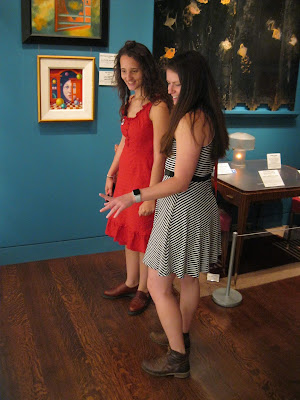Little Dove at the Doctor
In our last post we talked about the beginning of the journey of our Arthur Dove Fog Horns piece that began when we took it off display so that it could be assessed by a painting conservator. This post will be focusing on what we learned from watching the assessment.
Conservators on the job have one main goal: to preserve the artists intent. Their job is not to strictly fix damage and clean the work, as often the issue is much more complicated than that. Often times, things that can be perceived as damage are actually just a part of the artists original techniques. An example is a 'holiday'. Not to be confused with vacation time, the term 'holiday' in the art conservation world refers to a gap in the paint that was a product of the artists style of brushwork. Without trained eyes, these 'holidays' can be mistaken for cracks or scratches.
The next step for a conservator is to assess what needs to be fixed. Are there cracks that might spread without attention? Varnish layers that need to be removed? Varnish layers that need to be added to protect the piece further? As these questions are asked, the conservator can develop of treatment plan for the work that is tailored to it's individual needs. No two works will have the exact same treatment.
Conservation is a fun mix of art and science. Conservators generally attend a 2-4 year graduate program that is eventually specified into a specific field of art conservation such as: painting, paper, or object-based. Subject-specificity is more important than ever as a wide array of new techniques and technologies allow conservators to create tailored treatment plans for the artworks.
Our internship allowed us to discuss many of these subjects with our conservator, and be a part of the condition assessment. She gave us the opportunity to look at the painting in-depth, and offer our own assessment which she could then critique and explain if we misinterpreted something. It was wonderful and we both valued her patience as we bombarded her with questions. We hope to take the experience and use it to improve the quality of our own condition reports going forward!
Check out this link for more information on conservation!
The next step for a conservator is to assess what needs to be fixed. Are there cracks that might spread without attention? Varnish layers that need to be removed? Varnish layers that need to be added to protect the piece further? As these questions are asked, the conservator can develop of treatment plan for the work that is tailored to it's individual needs. No two works will have the exact same treatment.
Conservation is a fun mix of art and science. Conservators generally attend a 2-4 year graduate program that is eventually specified into a specific field of art conservation such as: painting, paper, or object-based. Subject-specificity is more important than ever as a wide array of new techniques and technologies allow conservators to create tailored treatment plans for the artworks.
Our internship allowed us to discuss many of these subjects with our conservator, and be a part of the condition assessment. She gave us the opportunity to look at the painting in-depth, and offer our own assessment which she could then critique and explain if we misinterpreted something. It was wonderful and we both valued her patience as we bombarded her with questions. We hope to take the experience and use it to improve the quality of our own condition reports going forward!
Check out this link for more information on conservation!



Comments
Post a Comment